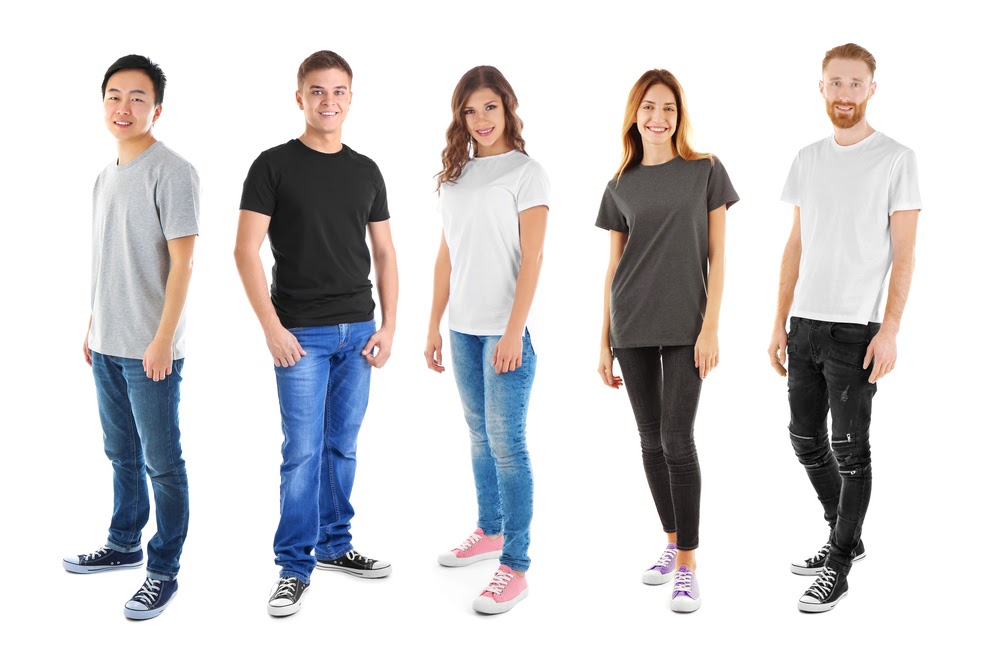
|
Getting your Trinity Audio player ready...
|
Polyester vs cotton vs blends? What is the scoop about them?
Have you ever about thought what fabric is used for the shirt you wear all the time? Or why do some of your t-shirts feel different from the others and if your shirts are made from the best shirt material? T-shirts are made from hundreds of different kinds of fabric and every fabric has a different style and feel.
We have outlined all the types of fabric from 60 cotton 40 polyester, and 100 polyester to cotton-polyester blend alongside a comparison of cotton vs polyester and tri-blend vs cotton. So, if you are interested in knowing your fabrics especially when buying or printing, then keep on reading.
The 3 Best T-Shirt Fabrics
Let’s talk about the three main categories of fabric that you need to know in order to make an informed decision:
100% Cotton
Cotton is the most commonly used fabric for t-shirts. It is a natural vegetable fibre, fluffy as well, that is obtained from a cotton plant’s seedpod and spun into yarn or thread. Cotton is used to make breathable shirts loved by everyone. Most t-shirts are made from cotton or partially cotton. Plus, it is hypoallergenic, so a personal favourite of people with skin prone to itches and rashes.
Feel and Wear of Cotton
Cotton can be knitted or woven into an array of fabrics, such as jersey, denim, and flannel. Each of which, of course, boasts a different wear purpose and feel. Plus, cotton feels very breathable and soft on the skin and is, thus, perfect for hot weather and warm climates, particularly, for people with sensitive skin.
Another plus is that cotton doesn’t cling to the skins, so if you want to start a business with loose-fitting clothes, then choose cotton. But also remember that 100% cotton is not the best choice for activewear because it dries rather slowly.
Cotton’s Printing Suitability
Cotton is the perfect surface for direct to garment printing. Opt for a garment made from 100% cotton if you want a crisp and opaque design. However, DTG prints don’t print as solid on thicker cotton garments, such as sweatshirts and hoodies, as they do on t-shirts.
Durability and Care
Cotton that is pure and high in quality is extremely durable which renders it immune to accidental tears or rips, but it isn’t as durable as polyester or cotton-polyester blend. It can also shrink at high temperature, so use cold water to wash a cotton shirt and don’t go overboard with the detergent.
100% Polyester
Polyester is a synthetic fabric known for its durability and resiliency. It dries quickly, also called moisture-wicking, because of its low moisture absorbency and is also known as hydrophobic. 100% Polyester always maintains its shape, so no matter how you wash it, it doesn’t stretch or shrink. Moreover, it’s the go-to fabric of adventurous and athletic people because of its durability in extreme conditions and resistance to odour. And it doesn’t stain, so that’s another reason why people prefer it.
What Does Polyester Feel Like?
Polyester is lightweight, feels silkier than cotton, perfect for sports, and traps sweat against the skin, which is why it may feel clammy and cooler in warm and cooler weather, respectively.
Polyester is light and thin, so it can cling to the skin and cause irritation for people with extremely sensitive skin. However, this is not common with polyester blends. In addition, it is stretchy and doesn’t shrink or lose its shape even after a lot of wear and tear.
Polyester’s Printing Suitability
Printing on polyester can be a challenge but, thanks to advanced printing services and special dyes, it has now become easy to achieve high-quality prints on polyester. Printed colours on polyester now turn out very vibrant and are very unlikely to fade with time.
Durability and Care
Polyester is more durable than cotton and most blends, but it’s also hard to stain it permanently because of its lower absorbency. Polyester is also famous for its resistance to fading, shrinking and wrinkling. We recommend washing polyester clothes with all-purpose detergent in warm water followed by a low-temperature tumble-dry.
| Polyester vs Cotton in a Nutshell | ||
| Attributes | Cotton | Polyester |
| Feel and Wear | ||
| Lightweight | ╳ | ✓ |
| Clingy | ╳ | ✓ |
| Silky | ╳ | ✓ |
| Quick-Drying | ╳ | ✓ |
| Soft | ✓ | ✓ (less than cotton) |
| Breathable | ✓ | ✓ |
| Sensitive Skin-Friendly | ✓ | ╳ |
| Printing | ||
| All-Over Method | ╳ | ✓ |
| Colour Vibrancy | ✓ | ✓ |
| DTG Method | ✓ | ╳ |
| Durability and Resiliency | ||
| Prone to Fading | ✓ | ╳ |
| Prone to Shrinking | ✓ | ╳ |
| Prone to Tearing | ╳ | ╳ |
| Prone to Wrinkling | ✓ | ╳ |
Blends
When it comes to blends, the majority of people find them confused over a myriad of questions, such as what is cotton blend, are there 100% polyester shirts that feel like cotton, is polyester cotton, or what is poly cotton and the list never seeds to end. So, what is actually is a blend?
A blend is a fabric or yarn made from more than one kind of fibre. They are huge in the t shirt printing market because they provide the best of both worlds and the best of three worlds in the case of tri-blends. Let’s look at the major types of blends:
- Tri-Blend: Usually made using rayon, cotton, and polyester.
- CVC: Also known as Chief Value Cotton is a blend with most of it being cotton.
- 50/50: It is a 50/50 blend containing half polyester and half cotton, which is why is it also called cotton/poly.
Now, that we know the basics of the basic blends available in the market, let’s look at some blends in detail:
Polyester-Spandex Blends (85/15)
Spandex is a synthetic fibre famous for its elasticity. It is also called lycra or elastane. It makes the perfect fabric for soft clothing that is also durable when it is combined with cotton. Polyester-spandex blend garments are most commonly worn in activewear because spandex comes through with its stretchy nature and the ability to keep its original shape, while polyester provides the durability.
Cotton-Polyester Blends (65/35 and 50/50)
Cotton-polyester is perfect for you if you cannot choose between polyester and cotton. It is versatile and used to make shirts, and bedding, and whatnot. These blends are easier to wash and dry because the polyester does not shrink or change its shape, unlike cotton.
And the garments are also breathable, unlike the pure polyester clothes, courtesy of the cotton component in the blend. Lastly, the cotton-polyester blend makes the greatest canvas for colourful and bright designs.
Polyester-Cotton-Rayon Blend (50/25/25)
These blends have the best proportion of three types of fabric because of rayon being a semi-synthetic fibre that combines them together. Garments made using this fabric are stretchy, soft, and durable. So, if you want to make loose-fitting clothes that have a snug feel to them, go for this tri-blend. Another perk of the tri-blend is that it delivers the famous so-called vintage feel when printed on using the DG method. This is because of the looser weave and combination of the three fabrics and the fabrics show through the ink slightly.
Which T-Shirt Fabric Is the Best for You?
This answer depends on different requirements, and we have broken them down for you:
- The person wearing the shirt: Fashion style, expectation, age range, etc.
- The qualities you want: Moisture-wicking, durability, structure, softness, breathability, etc.
- The print method: Sublimation, direct-to-garment, screen printing, digital transfer, embroidery, vinyl transfer, etc.
- The price range: Maximum amount per item for the complete order.
- The purpose of the piece of apparel: Sports event, work uniform, merchandise, family reunion, etc.
Here’s a short and straightforward breakdown of the pros and cons of three types of fabrics:
| Pros and Cons of 100% Cotton, 100% Polyester and Blends | |
| 100% Cotton | |
| Pros | Cons |
| Breathable | Generally Heavier |
| Popular | Can Be Prone to Shrinkage |
| Soft | Can Get Stained |
| Non -Clingy | Dries Slowly |
| Comfortable | Prone to Damage |
| Gentle on the Skin | Prone to Wrinkling |
| Easily Customised | DTG Prints Aren’t Solid on Thicker Cotton |
| 100% Polyester | |
| Pros | Cons |
| Lightweight | Very Clingy |
| Doesn’t Shrink nor Wrinkle | Can Irritate the Skin |
| Silky Smooth Drape | Less Breathable |
| Odour Resistant | Have Restrictions on Printing |
| Super Durable | Feels Synthetic |
| Super Quick-Drying | Some Are Very High Priced |
| Blends (Cotton/Polyester) | |
| Pros | Cons |
| Soft and Comfy | A Bit Clingy |
| Better Drape and Lightweight | Irritating to Sensitive Skin |
| Less Wrinkling and Shrinkage | Can Be Priced Quite High |
| Quicker Drying and More Durable | Minor Restriction on Printing |
So, Which One Is Right for You?
100% Cotton: Choose 100% cotton if you want breathable, gentle, comfortable, soft, and customisable shirts. However, these shirts can shrink, wrinkle, strain, and absorb moisture, but they are still a safe bet because they are popular with just about every person out there.
100% Polyester: Go for polyester if you want silky smooth, resistant to wrinkles, shrinking, or fading, durable, quick-drying, and lightweight shirts. But polyester is clingy, irritating, print restricted, and less breathable, and its price can be quite high based on the brand.
Blends: The best choice if you want to enjoy the best of the both worlds. You can get a variety of them, including, the poly-cotton 50/50, the tri-blend that has rayon for extra softness and drape, and CVC with predominant cotton. Tri-blends the best, but they can be a bit expensive, still affordable nevertheless.
The Final Takeaway
There you go. This is all the information you need about polyester vs cotton vs blends in order to make an informed decision whether you want to buy a t-shirt for yourself or start your own business of custom printed garments. Take your time studying the types of fabric until you find the one that fits your needs perfectly and, then go for it.
Suggested Reads:
- Does Polyester Shrink? Myths and Facts
- Why Eco Friendly T Shirt Are Preferable?
- 5 Summer T Shirts Style Australia 2021/22













